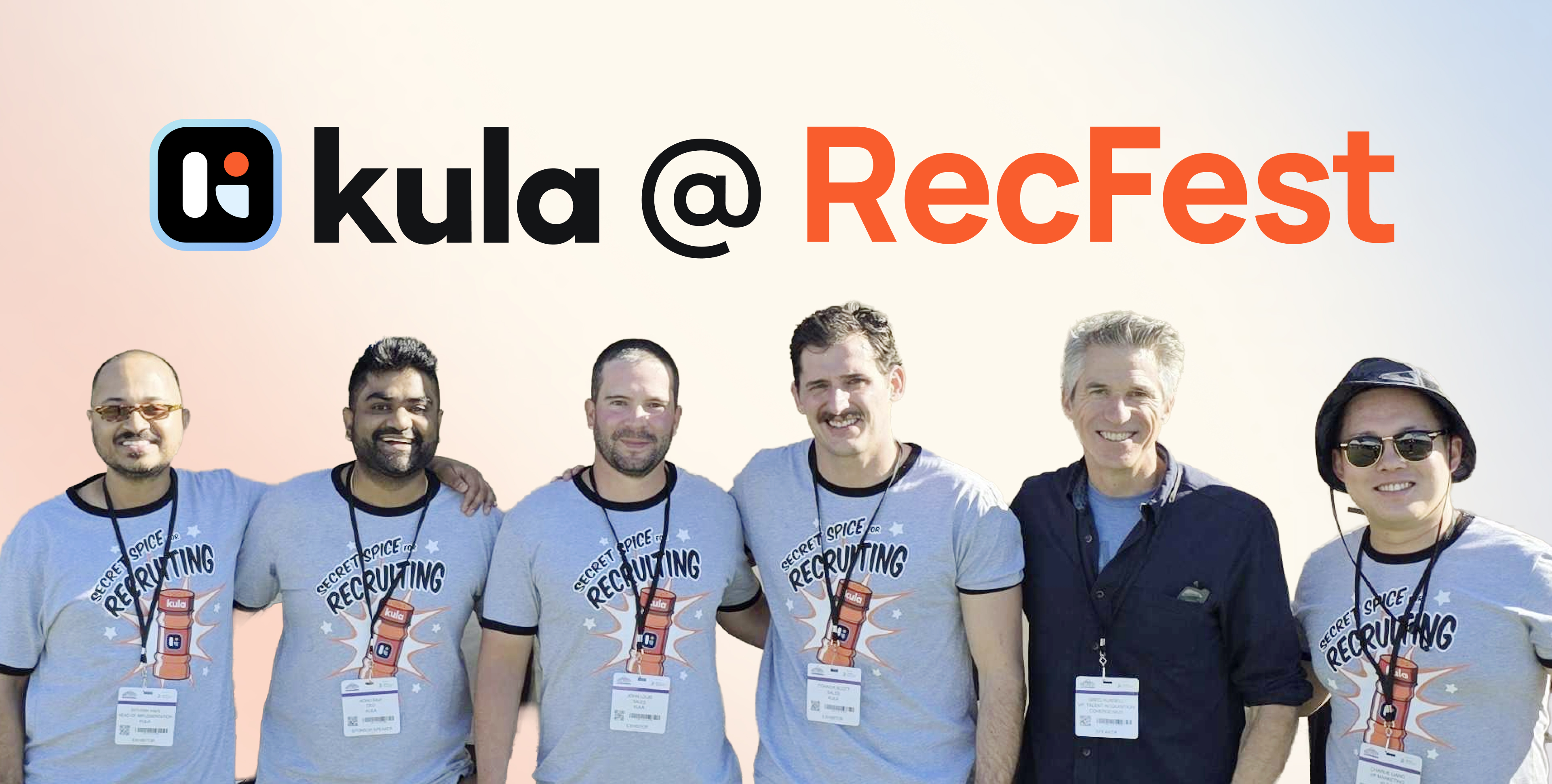Book a 30-minute demo and learn how Kula can help you hire faster and smarter with AI and automation
If you’re a recruiter going after passive talent, you must know by now that sourcing candidates is not as easy as it sounds. Agreed, we do live in the age of the internet, and we can access and speak to desired candidates in so many ways, but having more options = more complexity, confusion, and ultimately, exhaustion.
That’s why we, at Kula, decided to put together a comprehensive candidate sourcing guide for you. Bookmark this blog, it’s going to be your go-to resource for everything applicant sourcing, the best ways and hacks to source candidates, a list of best practices, and more.
Firstly, what is candidate sourcing?
Candidate sourcing is proactively seeking and identifying candidates who could be a good fit for your company. Recruiters like you, by sourcing candidates, are essentially creating a bank of really great candidates that they can tap into when the need arises. It could be for a current opening, or for a vertical your company is planning to launch in the future, or for unforeseen job roles that might open up.
The candidates that you are sourcing could be from two brackets:
- They’re actively looking for jobs
- They’re already working elsewhere, but since you find their profile relevant, you establish comms to sign them if and when they’re ready
3 must-haves before setting out to source candidates
We’re going to discuss the best ways to source applicants, but before that, let's talk about the knowledge that you, the recruiter, must be equipped with.
1. Understanding your company culture
Every organisation has certain things it treasures: examples are working fully remote, or onsite, encouraging diverse people from different geographies to be a part of the team, working in a flat structure, and more. You need to understand the needs of your org before setting out to source candidates for it.
For instance, if you find an exceptional candidate but they’re only willing to work remotely, and your office needs people to be on-site full time, there’s no point in you pursuing that lead and adding them to the funnel.
2. Learning the requirements of the job role
When there’s an opening for a profile that you’re not fully aware of, it’s on you to learn the nuances of what’s expected from that role. You can speak to the hiring manager to understand what they expect the candidate to know, the kind of experience they prefer, the interpersonal skills required, and more.
The more aligned you are with the hiring manager’s expectations, the quicker it will be for you to find the right profile. If not, you might end up spending weeks sourcings a dozen profiles only to realise none of them are a good fit.
3. Getting insight into the industry
It’s a fast changing world, and with the entry of AI-powered everything, every industry is being disrupted. Before sourcing candidates, you need to understand how that particular industry functioned until now, the different titles that have opened up, the list of skills that the role would require, and more.

4 key candidate sourcing channels
Did your research on the company culture, industry and skills required for the job? Now, let’s get down to business. The first step to sourcing candidates is identifying all the right channels. And since there are quite a few, let’s list them down:
Sourcing through employment-focused networking platforms
LinkedIn, Indeed, Glassdoor, AngelList, The Muse, are some of the top platforms that your candidates scout on a regular basis. You can post your openings here, connect with relevant folks, and also message them directly to start a conversation. This is the most preferred way for recruiters to hire passive talent.
Sourcing through events and job fairs
Hosting intimate networking events, as well as bigger employment fairs, is a great way to get the word out that you’re actively recruiting. This has been a go-to channel, primarily to hire freshers graduating from college, for decades now. If you’re hiring for just a few, niche roles, or to fill in certain spotlight C-suite positions, this channel will not be a suitable one to serve your purpose.
Sourcing via internal employee referral programs
The lowest in terms of employee attrition, referral programs are the go-to for many companies looking to hire passive candidates. Offering cash rewards or e-coupons to motivate employees to refer their friends, recruiters often opt for this strategy so they can hire candidates who will fit seamlessly into the company culture.
Sourcing via social media
Recruiters, hiring managers, and even employees within the org post open roles on their Instagram, Facebook and Twitter feed, to get their friends to perhaps apply or share the posts with their friends looking for jobs. This has become particularly popular post the layoff wave in the last couple of quarters. In order to help their impacted friends out, people who come across job openings are diligently resharing them on social media.
The most effective strategy to source candidates
Here’s the golden rule to sourcing candidates effectively: Use all the channels available to you. This includes employment-focused networking platforms like LinkedIn, Indeed and more; events and fairs; social media like Twitter, Facebook, even Instagram; and internal employee networks.
The best recruiters and talent leaders out there don’t limit their outreach efforts to one channel. They’re open to exploring new channels, and malleable to learning sourcing hacks across channels.
Read More: Effective Candidate Sourcing Strategies
The best practices of candidate sourcing
We’ve summed up all the best practices you need to follow while sourcing candidates:
- Candidate Experience
- Engage & Exciting job description
- Make full use of filters
- Craft the dream candidate profile
- Network some more
- Tap into all channels
- Build employer brand
- Effective usage of Tech & AI
Let's dig into more,
1. Always think about the candidate experience
Think beyond the screen. There’s a living, breathing person behind that email that you’re sending out and it’s easy to forget that when you have a list of profiles flashing in front of you all day long. Whether you’re reaching out to the candidate, sending them follow-up emails, responding to their queries, or sending them a rejection notice, always keep their best interest in mind.
Practicing empathy is a crucial part of this job, and doing so can also make you approachable. This means that even if a candidate didn’t find the role appealing they might get in touch with you later on if they changed their mind.
2. Draft an engaging, exciting job description
It’s not just the salary that candidates want to know about. They want to learn about the causes your company supports, the leave policy, the work timings, and so much more. So when you’re trying to fill a position, and sending the link of the job description across candidate sourcing channels, you need to ensure it provides everything the candidate will need to know about.
From transparent pay information to the pet policy at your company, ensure the JD is informative, engaging and compelling enough for the candidate to feel inclined to join your company.
3. Make full use of filters
Almost every employment-focused networking platform and ATS has a host of filters that recruiters can make use of to find the candidate they’re looking for. If you know how to navigate these filters, you can even narrow down from 500 good profiles to a handful of really excellent ones.
Shortlisting on the right bunch of candidates with the use of filters can help you decrease time to fill and increase response rates.
4. Craft the dream candidate profile
Once you’ve spoken to the hiring manager, you must’ve gotten an idea of the kind of skills, experience and personality that the open role requires. Get your thoughts organised, and even go ahead and note down the ideal profile. Put pen to paper, or finger to keyboard, and craft the “dream” candidate profile.
When you’re applying filters to find the most suitable candidate, this little exercise will help you in a big way.
5. Network, and then network some more
Build an online presence on LinkedIn, attend job fairs and events, speak to other recruiters, partner with universities, sponsor college events, simply go all out in building your network. This is key to not jsut recruiting for your org, but for your career path as a recruiter. Social currency is monumental to a recruiter, and the energy you spend on building your network is going to help you go a long way.
6. Tap into all channels
We’ve said this before and we’ll say it again. Don’t by shy in tapping into different avenues. Make sure you source candidates across job posting sites, events, social media, and internal employee networks. This can also help you build your network across channels.
7. Build your employer brand
Candidate sourcing simply becomes easier when candidates you’re reaching out to have already heard about your company. For that, your company needs to have a good PR effort, and be vocal on social and other digital mediums.
8. Make use of tech and AI
There are a host of tools out there to make candidate sourcing easier. You need to know which tool works best for you, and subscribe to that so you can automate everything that can be automated. This will give you time to sit back, and think, in order to build your network.

Read Also: How AI in Recruiting Transforms Talent Acquisition Processes
Leveraging tech to find success in candidate sourcing
Kula helps make candidate sourcing across channels easier with its Kula Everywhere Chrome extension. The box will just slide in across any channel that you’re sourcing from: LinkedIn, GitHub, or the wide open internet and you can simply add your desired candidate to the flow. Your candidate sourcing efforts will become super easy, and can be completed within seconds.

To sum up, candidate sourcing is best achieved by adopting a multi-channel, highly personalised approach, along with making efficient use of tech and AI. The other inclusions are practising empathy and building a vast network.
Happy sourcing! If you have any questions or feedback, feel free to ping us.






















